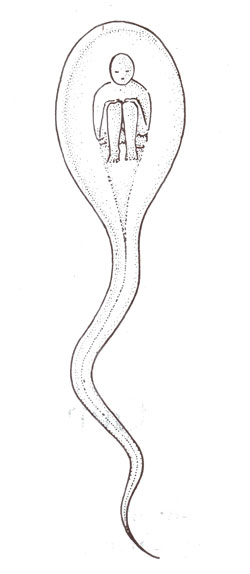Preformation and epigenesist
Although the basic idea of heredity that traits are transferred from one generation to the other was known since thousands of years in the past, but the actual physical link was not kn6wn. With the discovery of sexuality it could be suggested that hereditary traits must be transmitted either through egg or through sperm or both.
In 1679, J. Swammerdam studied development of insects and suggested that development of an organism is a simple enlargement of a minute but preformed individual. This preformed individual was called homunculus (Fig. 1.1.) and could be present in the sperm or in the ovum. During eighteenth and nineteenth centuries, there was a controversy among preformationists. Workers who attached more importance to the ovum were called ovists and they thought that homunculus was present in the ovum. Other workers like Leeuwenhoek who attached more importance to sperm were called animalculists, who insisted that a miniature but complete organism was present in the sperm.
Soon it was realized that preformation theory could not be accepted. One of the most important
objections was that homunculus was later found to be the creation of imagination of earlier workers and could never be observed in subsequent studies.
K.W. Wolff (1738-1794) proposed that neither egg nor sperm had a structure like homunculus but that the gametes contained undifferentiated living substance capable of forming the organized body after fertilization. Such an idea was called the theory of epigenesis. This theory suggested that many new organs and tissues, which were originally absent, develop de novo due to mysterious vital forces. Such, however was not the case and now we know that although the organism is not preformed, but its characteristics are predetermined by the sperm and ovum taking part in fertilization.
In 1679, J. Swammerdam studied development of insects and suggested that development of an organism is a simple enlargement of a minute but preformed individual. This preformed individual was called homunculus (Fig. 1.1.) and could be present in the sperm or in the ovum. During eighteenth and nineteenth centuries, there was a controversy among preformationists. Workers who attached more importance to the ovum were called ovists and they thought that homunculus was present in the ovum. Other workers like Leeuwenhoek who attached more importance to sperm were called animalculists, who insisted that a miniature but complete organism was present in the sperm.
K.W. Wolff (1738-1794) proposed that neither egg nor sperm had a structure like homunculus but that the gametes contained undifferentiated living substance capable of forming the organized body after fertilization. Such an idea was called the theory of epigenesis. This theory suggested that many new organs and tissues, which were originally absent, develop de novo due to mysterious vital forces. Such, however was not the case and now we know that although the organism is not preformed, but its characteristics are predetermined by the sperm and ovum taking part in fertilization.





